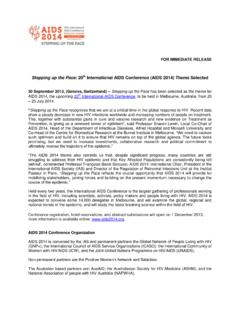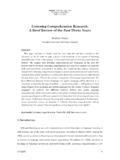Transcription of 1 chapter one - WHO
1 1chapter onemothers and children matter so does their healthThe healthy future of society depends on the health of the children of today and their mothers, who are guardians of that future. However, despite much good work over the years, million children and 529 000 mothers are still dying each year, mostly from avoidable causes. This chapter assesses the current status of maternal and child health programmes against their historical background. It then goes on to examine in more detail the patchwork of progress, stagnation and reversals in the health of mothers and children worldwide and draws attention to the previously underestimated burden of newborn pregnant women hope to give birth safely to a baby that is alive and well and to see it grow up in good health.
2 Their chances of doing so are better in 2005 than ever before not least because they are becoming aware of their rights. With today s knowledge and technol-ogy, the vast majority of the problems that threaten the world s moth-ers and children can be prevented or treated. Most of the millions of untimely deaths that occur are avoidable, as is much of the suffering that comes with ill-health. A mother s death is a tragedy unlike others, because of the deeply held feeling that no one should die in the course of the normal process of reproduction and because of the devasta-ting effects on her family (1). In all cultures, families and communities acknowledge the need to care for mothers and children and try to do so to the best of their ability.
3 An increasing number of countries have succeeded in improving the health and well-being of mothers, babies and children in recent years, with noticeable results. However, the countries with the highest burden of mortality and ill-health to start with made little progress during the 1990s. In some, the situ-ation has actually worsened in recent years. Progress has therefore been patchy and unless it is accelerated significantly, there is little hope of reducing maternal mortality by three quarters and child mortality by two thirds by the target date of 2015 the targets set by the Millennium Declaration (2, 3). In too many countries the health of mothers and chil-dren is not making the progress it should.
4 The reasons for this are complex and vary from one country to an-other. They include the familiar, persistent enemies of health poverty, inequality, war and civil unrest, and the destructive influence of HIV/AIDS but also the failure to The World Health Report 20052translate life-saving knowledge into effective action and to invest adequately in public health and a safe environment. This leaves many mothers and children, particularly the poorest among them, excluded from access to the affordable, effective and re-sponsive care to which they are centuries, care for childbirth and young children was regarded as a domestic affair, the realm of mothers and midwives.
5 In the 20th century, the health of mothers and children was transformed from a purely domestic concern into a public health priority with corresponding responsibilities for the state. In the opening years of the 21st century, the Millennium Development Goals place it at the core of the struggle against poverty and inequality, as a matter of human rights. This shift in emphasis has far-reaching consequences for the way the world responds to the very uneven progress in different EARLY YEARS OF MATERNAL AND CHILD HEALTH The creation of public health programmes to improve the health of women and chil-dren has its origins in Europe at the end of the nineteenth century.
6 With hindsight, the reasons for this concern look cynical: healthy mothers and children were seen by governments at that time to be a resource for economic and political ambitions. Many of Europe s politicians shared a perception that the ill-health of the nation s children threatened their cultural and military aspirations (4). This feeling was particularly strong in France and Britain, which had experienced difficulties in recruiting soldiers fit enough for war. Governments saw a possible solution in the pioneering French experiments of the 1890s, such as L on Dufour s Goutte de lait (drop of milk) clinics and Pierre Budin s Consultations de nourrissons (infant welfare clinics) (5).
7 These programmes offered a scientific and convincing way to produce healthy children who would become productive workers and robust soldiers. The programmes also increas-ingly found support in the emerging social reform and charitable movements of the time. As a result, all industrialized countries and their colonies, as well as Thailand and many Latin American countries, had instituted at least an embryonic form of maternal and infant health services by the onset of the 20th century (6). The First World War ac-celerated the movement. Josephine Baker, then Chief of the Division of Child Hygiene of New York, summed it up as follows: One of the first maternal and child health clinics, in the late 19th century, was L uvre de la goutte de lait : Dr Variot s consultation at the Belleville Dispensary, and children matter so does their health It may seem like a cold-blooded thing to say, but someone ought to point out that the World War was a back-handed break for children.
8 As more and more thousands of men were slaughtered every day, the belligerent nations, on whatever side, began to see that new human lives, which could grow up to replace brutally extinguished adult lives, were extremely valuable national assets. [The children] took the spotlight as the hope of the nation. That is the handsomest way to put it. The ugliest way and, I suspect, the truer is to say flatly that it was the military usefulness of human life that wrought the change. When a nation is fighting a war or preparing for another .. it must look to its future supplies of cannon fodder (7).Caring for the health of mothers and children soon gained a legitimacy of its own, beyond military and economic calculations.
9 The increasing involvement of a variety of authorities medical and lay, charitable and governmental resonated with the rising expectations and political activism of civil society (1). Workers movements, women s groups, charities and professional organizations took up the cause of the health of women and children in many different ways. For example, the international Labour Organization proposed legal standards for the protection of maternity at work in 1919; the New York Times published articles on maternal mortality in the early 1930s; and in 1938 the Mothers Charter was proclaimed by 60 local associations in the United King-dom.
10 Backed by large numbers of official reports, maternal and child health became a priority for ministries of health. Maternal and child health programmes became a public health paradigm alongside that of the battle against infectious diseases (8).These programmes really started to gain ground after the Second World War. Global events precipitated public interest in the roles and responsibilities of governments, and the Universal Declaration of Human Rights in 1948 by the newly formed United Nations secured their obligation to provide special care and assistance for mothers and children (9). This added an international and moral dimension to the issue of the health of mothers and children, representing a huge step forward from the political and economic concerns of 50 years earlier.












